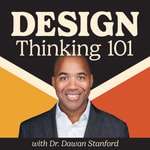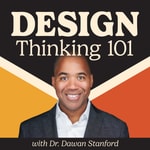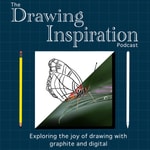Design Thinking 101 – Details, episodes & analysis
Podcast details
Technical and general information from the podcast's RSS feed.

Design Thinking 101
Dawan Stanford
Frequency: 1 episode/17d. Total Eps: 141

Recent rankings
Latest chart positions across Apple Podcasts and Spotify rankings.
Apple Podcasts
🇬🇧 Great Britain - design
20/11/2024#96🇬🇧 Great Britain - design
19/11/2024#68🇬🇧 Great Britain - design
18/11/2024#41
Spotify
No recent rankings available
Shared links between episodes and podcasts
Links found in episode descriptions and other podcasts that share them.
See all- https://asana.com/
500 shares
- https://www.loom.com/
363 shares
- https://www.paypal.com/us/home
310 shares
RSS feed quality and score
Technical evaluation of the podcast's RSS feed quality and structure.
See allScore global : 53%
Publication history
Monthly episode publishing history over the past years.
Joy, Transformation, and Design as Creative Liberation with Sahibzada Mayed — DT101 E141
Episode 141
mardi 29 octobre 2024 • Duration 49:58
Sahibzada Mayed is a creative alchemist who uses design and storytelling to cultivate joy and imagination as tools of liberation. Mayed serves as the Co-Lead for Strategy and Research at Pause and Effect, a liberation-focused imagination and design collective based on Coast Salish territories of the Musqueam, Squamish, Tsleil-Waututh Nations. Beyond that, Mayed leads a small-scale startup, Naranji, that focuses on gender justice and decolonization in fashion. Today, we talk about decolonizing design and creative liberation.
Listen to learn about:
>> The impact of colonialism and power structures on design
>> The need for critical social analysis in design
>> Designing for Joy
>> Decolonizing design
>> The importance of locality and place in design
>> Rethinking how we think about and experience systems
Our Guest
Sahibzada Mayed is a creative alchemist who uses design and storytelling to cultivate joy and imagination as tools of liberation. Mayed serves as the Co-Lead for Strategy and Research at Pause and Effect, a liberation-focused imagination and design collective based on Coast Salish territories of the Musqueam, Squamish, Tsleil-Waututh Nations. Beyond that, Mayed leads a small-scale startup, Naranji, that focuses on gender justice and decolonization in fashion. Their work has been prominently featured during New York and Chicago Fashion Weeks and highlighted in several publications across the United States, Pakistan, Thailand, and Japan. Mayed's identity is shaped by their background as a Muslim immigrant of Persian, Afghan, Indian, and Pakistani heritage, as well as lived experiences of queerness, disability, and neurodivergence.
Show Highlights
[02:15] Mayed’s unconventional journey into design, combining engineering and social sciences.
[04:05] How this background has helped Mayed in their work.
[06:01] Mayed’s current work focus is on understanding the impact of colonialism in design.
[07:36] The challenge of collaborating when existing power differentials have yet to be addressed.
[09:28] What is power?
[12:04] Mayed shares thoughts on designing when you’re close to, or a part of, the community you’re designing for, versus being outside that community.
[13:53] Dawan talks about how perfection is the enemy of change.
[15:57] The fear and discomfort of taking responsibility for causing harm.
[16:28] Good intentions do not absolve responsibility.
[17:30] Building accountability into what you design.
[19:19] Ethics in design and looking for the potential of harm while designing.
[22:45] There is an assumption of neutrality and objectivity around design.
[24:47] Designing to prevent harm, and also designing for joy and compassion and care.
[29:45] Decolonizing design.
[35:12] Grounding design in the context of the place and space where it will live.
[38:47] Shifting the way we think about design, to move beyond the human.
[40:44] Rethinking how we think about and experience systems.
[45:13] Last thoughts from Mayed about doing the work and the responsibility that comes with that.
Links
Mayed on LinkedIn
Mayed on Medium
Mayed’s website
pause + effect - 5-week intensive, Reimagining Research
Interview: Fashion Designer Sahibzada Mayed
Cultivating Design Ecologies of Care, Community, and Collaboration
I Don’t Want A Seat at Your Table w/ sahibzada mayed
Decentralizing Power through Design with Sahibzada Mayed and Lauren Lin
Book Recommendations
Emergent Strategy: Shaping Change, Changing Worlds, by Adrienne Maree Brown
DT 101 Episodes
Design Social Change with Lesley-Ann Noel — DT101 E128
Radical Participatory Design + Relationships in Complex Systems Inclusive Design with Victor Udoewa — DT101 E127
Design Ethics with George Aye — DT101 E136
Healthcare Design: Evidence-based, Business Fluent, and Change Prepared with Matt Van Der Tuyn — DT101 E140
Episode 140
mardi 24 septembre 2024 • Duration 42:38
Matthew Van Der Tuyn is a designer and healthcare innovation strategist. Matt is the Senior Director of Design and Strategy at the Center for Health Care Transformation and Innovation at Penn Medicine. The mission at the Center is to serve as a catalyst and accelerator for initiatives that dramatically improve health outcomes, patient and provider experiences, and decrease the cost of care. Matt has had the unique opportunity to help build the Center’s design, discipline, and elevate design thinking as a key tool in Penn Medicine's organizational toolbox. Matt's design process balances divergent and creative thinking to push beyond incremental solutions with the rigor of an evidence-based approach. We talk about becoming and being a designer in healthcare and Matt's practice.
Listen to learn about:
>> The unique challenges of designing and innovating in the healthcare space
>> Problem-centric vs solution-centric thinking and action
>> The importance of change management in the design process
Our Guest
Matt is a designer and health care innovation strategist. Matt’s design roots are in information, product, and service design. His design practice began with visual arts, information design, and product design for luxury goods before deciding to pivot into design for social impact. With this new focus on using design to solve societal issues, Matt’s work expanded into the design of services and co-design as a tool for empowering disadvantaged communities. Matt’s guiding principle is that design is a mindset that anyone can leverage, and that the role of the “Designer” is to help others tap into this mindset to imagine new possibilities.
In 2012, Matt made a leap into health care when he joined the newly minted Center for Health Care Transformation and Innovation at Penn Medicine (CHTI). The mission of this new center was to serve as a catalyst and accelerator for initiatives that dramatically improve health outcomes, patient and provider experiences, and decrease the cost of care.
Entering as the first designer on this new team, Matt has had the unique opportunity to help build CHTI’s design discipline and elevate design thinking as a key tool in Penn Medicine’s organizational toolbox. Matt’s design process balances divergent and creative thinking to push beyond incremental solutions with the rigor of an evidence-based approach.
Matt leads with the belief that the foundation of great design, and building a culture of innovation, is empowerment. That the greatest ingredient for innovation in any large service organization is the people on the front lines of service delivery who have the passion, insight, and opportunity to effect change. However, there are not often clear pathways for these staff to gain traction with ideas nor are there efficient ways for leadership to identify and support these frontline champions. Matt believes bridging this gap, through design, between high-level organizational objectives and the frontline staff with the answers, where agency is created for innovation, is the key to unlocking the true potential of an organization.
Matt does not see design as a silver bullet, but rather a binder that can align the many, diverse, voices and skills needed for transformative solutions. In addition to design, Matt will quickly point to the various disciplines and individuals across Penn Medicine that he feels create the secret sauce that makes anything possible. From behavioral economists to data scientists, quality and safety experts to hospitality experts, Matt is a firm believer that everyone has something to contribute, if we center ourselves around a shared set of values that prioritize improving the lives of others.
Show Highlights
[02:02] Matt’s love of the fine arts, and why he ended up in graphic design.
[02:34] Evolving from graphic design into product design of dinnerware.
[03:25] The book that helped change Matt’s design path.
[04:33] Grad school at the University of Arts in Philadelphia.
[05:44] How Matt’s grad school project with Penn Medicine led to the creation of the Center he works at today.
[09:30] Being problem-centric instead of solution-centric.
[12:45] The unique challenges of innovation work in healthcare.
[14:26] One of Matt’s big “a-ha!” moments.
[15:29] An exercise Matt uses to help people move past assumptions and think creatively.
[18:31] Looking for the people who really wanted the help.
[19:34] Storytelling in Matt’s work.
[22:28] The need for rigor and evidence when designing for healthcare.
[24:42] Matt encourages new designers to find ways to measure the success of their work.
[25:44] Getting comfortable with the business and finance side of healthcare.
[29:38] The importance of good change management.
[30:55] Using behavior design to help people with change.
[31:27] Conflict as a natural part of the design process.
[35:57] Matt’s advice for those wanting to work in healthcare design.
[38:32] Books and resources Matt recommends.
Links
Matthew on LinkedIn
Matthew at UPenn Medicine
Penn Medicine: Center for Health Care Transformation and Innovation
A Global Pandemic Turned Everything Upside Down. What Has Penn Medicine’s Innovation Team Learned From That?
Book Recommendations
Design Revolution: 100 Products The Empower People, by Emily Pilloton
The Presentation of Self in Everyday Life, by Erving Goffman
DT 101 Episodes
Healthcare + Systems + Risk + Design with Rob Lister — DT101 E122
A Designer’s Journey into Designing for Health and Healthcare with Lorna Ross — DT101 E45
Designing Health Systems + Creating Effective Design Workshops with Sean Molloy — DT101 E44
Talk to the Elephant: Design Learning for Behavior Change with Julie Dirksen — DT101 E131
Episode 131
jeudi 14 mars 2024 • Duration 01:05:58
Julie Dirksen is the author of the books Design for How People Learn and Talk to the Elephant: Design Learning for Behavior Change. She is a learning strategy consultant with a focus on incorporating behavioral science into learning interventions. Julie was my guest for episode 42 of the show. In this episode, we talk about her latest book, ways to motivate learners and workshop participants, designing learning experiences for skill development, and more.
Listen to learn about:
>> Julie’s latest book, Talk to the Elephant: Design Learning for Behavior Change
>> Behavior change challenges
>> The biggest challenge when creating virtual learning experiences
>> Motivating and engaging learners
>> AI in education
Our Guest
Julie Dirksen is the author of the books Design For How People Learn and Talk to the Elephant: Design Learning for Behavior Change. She is a learning strategy consultant with a focus on incorporating behavioral science into learning interventions. Her MS degree is in Instructional Systems Technology from Indiana University. She’s been an adjunct faculty member at the Minneapolis College of Art and Design and is a Learning Guild Guildmaster.
She is happiest when she gets to learn something new, and you can find her at usablelearning.com.
Show Highlights
[02:02] Julie gives a quick summary of her first book and how Talk to the Elephant is its natural sequel.
[02:42] The new book tackles the challenges in actually changing behavior.
[04:26] On learning experiences.
[05:21] Julie is starting to organize a third book, which will be on skill acquisition.
[05:34] The evolution of behavioral design.
[06:21] The COVID-19 pandemic is the biggest behavior change experiment in the history of the world.
[07:06] The book’s audience are those in the learning and development field — people who design learning experiences.
[08:00] The Change Ladder.
[08:54] Julie offers one case study she uses in the book to demonstrate the challenges around behavior change.
[14:17] The importance of communicating and working with the people you serve when it comes to changing behaviors.
[14:58] Julie tells a story illustrating the importance of talking to and understanding the people you serve and their needs.
[17:57] It’s important for people to participate in their own behavioral design.
[20:15] Creating the conditions for learners to motivate themselves.
[21:22] Making things as easy as possible for someone to do.
[22:42] A Miro Moment.
[25:27] Creating learning experiences that engage learners.
[26:14] The biggest challenge in designing virtual workshops.
[27:55] Why Julie is interested in Virtual Reality.
[29:34] The top two challenges Julie sees in almost every behavior change.
[34:55] Immediate impact and immediate rewards help learners stay motivated.
[37:21] Helping learners see what they will be able to do with this new skill or new knowledge.
[42:53] Julie shows appreciation for how video games onboard players as a great example of guiding people along the learning curve.
[45:11] Designing learning experiences to make your learner feel smart and capable as they acquire new skills and knowledge.
[48:42] Julie talks about research on self-directed learning by Catherine Lombardozzi.
[49:20] Julie and Catherine will be doing a webinar on the key behaviors seen in good self-directed learners.
[52:05] Julie ponders how systems thinking and design fits into behavior change.
[52:54] Dawan and Julie talk about AI and its role in education.
Links
Julie on LinkedIn
Usable Learning
Designing for how people learn
Book Recommendations
Design for How People Learn, by Julie Dirksen
Talk to the Elephant: Design Learning for Behavior Change, by Julie Dirksen
Thinking, Fast and Slow, by Daniel Kahneman
Nudge: The Final Edition, by Richard Thaler and Cass Sunstein
How Change Happens, by Cass Sunstein
Misbelief: What Makes Rational People Believe Irrational Things, by Dan Ariely
Predictably Irrational, Revised and Expanded Edition: The Hidden Forces That Shape Our Decisions, by Dan Ariely
DT 101 Episodes
Learning Design + Designing for How People Learn with Julie Dirksen — DT101 E42
Learning Design with Yianna Vovides — DT101 E58
Adding System Awareness to System Design to Your Innovation Stack with Julie Guinn — DT101 E43
Innovation in Nursing Education + Design Thinking for Health with Marion Leary — DT101 E41
mardi 17 mars 2020 • Duration 43:55
Marion Leary is the Director of Innovation at the Pennsylvania School of Nursing. We discuss innovation and nursing education, University of Pennsylvania’s free online Design Thinking for Health platform, nurses as innovation leaders, and why storytelling matters. Show host: Dawan Stanford.
Show Summary
Design thinking was not Marion’s first focus. She was a researcher for 13 years before taking the role of Director of Innovation at the University of Pennsylvania School of Nursing. She has a dual degree, with a Master’s in Nursing and Public Health. Marion is currently pursuing her Ph.D., focusing on innovation and design thinking around cardiac arrest and bystander response. She is interested in using design thinking to solve problems in nursing and healthcare.
Marion enjoys the empathetic, human-centered approach of creatively solving problems in health and healthcare, which connects with nursing. She is a leader in design thinking and created the course Innovation and Health Foundations of Design Thinking using a flipped-classroom, active-learning approach. This interdisciplinary course at Penn can be taken by upper-level undergraduate or graduate students, regardless of their major.
Learn how Marion collaborates with other departments to create a successful design thinking cohort, how she coordinated the first Penn Nursing Innovation Accelerator Program, and how Marion is integrating design thinking into her curriculum.
Listen in to find out:
>> How nursing and design thinking are similar iterative processes
>> More about the Innovation and Health Foundations of Design Thinking course
>> How this design thinking course attracts students from many majors
>> Marion’s experience on campus leading design thinking students
>> Marion’s prediction for long-term trends in nursing and innovative design
Our Guest
Marion Leary is the Director of Innovation at the University of Pennsylvania's School of Nursing. As the Director of Innovation at Penn Nursing, she works to amplify and educate nurses as leaders in health and healthcare innovation, recently launching a free, online, open access platform called Design Thinking for Health. Ms. Leary is a member of the American Nurses Association's Innovation Advisory Committee, a Founding member of the Society of Nurse Scientists, Innovators, Entrepreneurs and Leaders (SONSIEL), and a member of the American Heart Association's Emergency Cardiovascular Care Innovation Subcommittee. This past August 2019, she was named as an Influencer of Healthcare winner in the category of Excellence in Innovation by the Philadelphia Inquirer. In 2017, she was named Geek of the Year for her outstanding achievements in Philadelphia's vibrant geek community in the areas of innovation, technology, and activism.
Show Highlights
[02:22] Marion walks us through her journey to her current position today.
[04:30] How nursing and design thinking are similar processes.
[06:11] Marion describes the design thinking course.
[09:12] Student experience in the design thinking classroom at University of Pennsylvania.
[11:10] Marion’s experience leading design thinking on campus at University of Pennsylvania.
[12:30] The first Penn Nursing Innovation Accelerator Program.
[14:05] Her prediction for long-term trends in nursing and innovative design.
[17:14] How do others outside of nursing use Marion’s design thinking resources?
[21:45] Focusing on storytelling as an integral part of design thinking.
[24:49] How healthcare leaders and designers can support nurses in their role.
[27:28] The type of listening that comes with nursing training.
[31:44] Scope of practice and human-centered design.
[35:45] How Marion is integrating design thinking into her curriculum.
[39:14] Resources to use for learning first-aid and first response techniques.
Links
Design Thinking for Health
Design For Health at UPenn
UPENN nursing
IDEO
Health Design Thinking by Bon Ku and Ellen Lupton
Design resources at UPenn
Marion Leary on Twitter
Marion Leary on the Web
Marion Leary Nursing Profile
Other Design Thinking 101 Episodes You Might Like
Designer's Role in Healthcare & Public Health + Studio Thinking with Jess Roberts — DT101 E21Nursing + Service Design + Healthcare Innovation with Brittany Merkle — DT101 E38
Healthcare Design Teams + Wellness + ScienceXDesign with Chris McCarthy — DT101 E24
________________
Thank you for listening to the show and looking at the show notes. Send your questions, suggestions, and guest ideas to Dawan and the Fluid Hive team. Cheers ~ Dawan
Free Download — Design Driven Innovation: Avoid Innovation Traps with These 9 Steps
Innovation Smart Start Webinar — Take your innovation projects from frantic to focused!
Behavioral Design X Service Design with Anne van Lieren — DT101 E40
mardi 3 mars 2020 • Duration 40:23
Anne van Lieren is a service designer and behavior design enthusiast. We talk about her path to joining Livework in the Netherlands as a service designer, where service design and behavioral design are converging, examples from her work, and what happens when you add behavioral design to journey mapping.
Anne discusses her path to Livework with Dawan Stanford, your podcast host. She started working part-time through Livework through the University of the Netherlands and eventually started working at Livework Design full time. Anne worked on numerous projects, including helping organizations to adopt design principles and practices, and innovation projects optimizing current client services or building new service pathways.
Show Summary
With her bachelor’s degree in design from the University of the Netherlands, Anne moved on to Strategic Project Design, which was mostly focused on Service Design. While working on many user research projects, she developed an interest in psychology and behavior, and in understanding why people behave in specific ways. So, she decided to start looking into behavioral science and how this applied to service design.
Find out how Anne bridges the understanding gap for clients within the context of mindset, why she believes experiences are the key to training her client’s mental mindset, and why she focuses on the human-centered mindset. Learn how Anne teaches her clients to be more collaborative, think across departments and stakeholders, and encourages companies to be more experimental.
Learn how Anne:
>> Uses situation-specific prototypes for solutions in the workplace
>> Teaches companies how to use new and existing tools for design
>> Works with creative agility and the positive design that results from working the creative mental muscle
>> Specifies the types of mindsets she focuses on in the context of experimental experiences with her clients
>> Deals with the expectations of clients looking for solid answers
>> Frames the dynamics involved in the design thinking process
>> Incorporates behavioral design in the design thinking process to influence others in their behavior
>> Builds and designs co-design workshops
Our Guest
Anne is a service designer and behavioral expert at Livework Studio. She leverages insights from behavioral science and Livework’s expertise in service design to create environments that make customers aware, active, and able to make better decisions. By fundamentally understanding behavior and designing behavioral interventions, she helps organizations to create a durable impact on behavior change. Her research into nudging was published at a major international conference on design research.
Show Highlights
[02:27] Anne’s path to becoming a service designer.
[03:30] How Anne’s journey took her to working with Livework Design.
[05:01] What process does Anne implement to assist clients in understanding mindset?
[06:38] Anne speaks about creative agility — the creative mental muscle.
[12:12] The source for Anne’s enthusiasm for design based on working with her students on design projects.
[13:52] How incorporating behavioral science basics is beneficial for design thinking.
[16:51] An emotional hot state example and how to design more thoughtful interaction with nudges.
[19:55] Nudges and rational overrides in the context of behavioral science.
[22:31] Negotiations on the delivery side and how Anne handles this conversation.
[24:17] Building and designing co-design workshops.
[27:00] Advice Anne gives for others building co-design workshops.
[29:52] How Anne started using journey maps during her thesis.
[33:31] Anne’s prediction for service design’s future and role.
[36:32] Working on difficult social issues.
Links
Livework Design Studio
Anne van Lieren at Livework
The Behavioural Insights Team Annual Update Report 2017–18
Podcast: You are not so smart
SDGC19 | Anne van Lieren: Customer Behaviour by Design - Influencing Behaviour Beyond Nudging
Contact Anne van Lieren
Anne van Lieren on Twitter
Anne van Lieren on LinkedIn
Book Recommendation
Nudge: Improving Decisions About Health, Wealth, and Happiness, by Cass Sunstein & Richard Thaler
Other Design Thinking 101 Episodes You Might Like
Teaching and Learning Service Design for Designers and Non-designers with Maurício Manhães — DT101 E34
Service Design in Healthcare Inside Multiple Business Contexts with Jessica Dugan — DT101 E22
Nursing + Service Design + Healthcare Innovation with Brittany Merkle — DT101 E38
Behavioral Science + Behavior Change Design + Social Impact with Dustin DiTommaso — DT101 E28
________________
Thank you for listening to the show and looking at the show notes. Send your questions, suggestions, and guest ideas to Dawan and the Fluid Hive team. Cheers ~ Dawan
Free Download — Design Driven Innovation: Avoid Innovation Traps with These 9 Steps
Innovation Smart Start Webinar — Take your innovation projects from frantic to focused!
The Evolution of Teaching and Learning Design with Bruce Hanington — DT101 E39
mardi 18 février 2020 • Duration 42:49
Welcome to the Design Thinking 101 podcast! I'm Dawan Stanford, your host. In today's episode I am joined by Bruce Hanington. He remembers being introduced to design as a small child with his father being a Commercial Designer. Initially headed for a career in architecture, his journey took a detour as an undergrad when he ended up graduating with a degree in Applied Psychology. But Bruce realized he wanted to get into design, and that he wanted to be on the creative side instead of just studying design. During his graduate work in industrial design, he continued his interest in dealing with the more human factors of design, primarily, how design affects everyday encounters and life.
After emerging with an Industrial Design education coupled with Applied Psychology, he landed in academia in the School of Design as a part of the Industrial Design core, able to teach in all the aspects of teaching he loves best, including form giving, human factors, and understanding the interpretation of objects with meaning and significance. His recent promotions included an appointment to the Head of Design at Carnegie Mellon six months ago.
Bruce believes technology, and the products which are a part of our life now as a direct result of technology, are the biggest game-changers for design thinking. The orientation of work toward social causes, and designing for social good, has become an established part of design thinking.
On disciplinary boundaries, “I think you see a broadening of boundaries so regardless of what form of design you may have a particular passion for and how you might study it, ultimately I think that designers have a more broad-based understanding of design and problem solving in general, and design methods, approaches and practices can be applied to almost any design.”
Bruce has seen a shift in design methods over time, especially in the surge of information via books and online courses. He recently authored his own book on design thinking, “Universal Methods of Design.” There’s been a shift in design thinking to design responsibly for everyday living to enhance people’s lives.
Listen in to find out the new hurdles of design thinking, what new companies are looking for concerning the design thinking process, and why design thinking is more of a philosophical approach. Find out Bruce’s opinion on which methods or approaches to design have changed the most in the past decade.
Our Guest
Bruce Hanington is a professor and head of the School of Design at Carnegie Mellon University in Pittsburgh, Pennsylvania. Prior to this, he was director of graduate studies, and program chair of industrial design. Bruce has dedicated his teaching and research to methods and practices for human-centered design, with an emphasis on design ethnography, participatory design, and the meaning of form in context.
In addition to working with industry partners through collaborative projects and executive education, his work has been published in Design Issues, The Design Journal, and Interactions, with chapters in Affective Sciences in Human Factors and Human-Computer Interaction, and The Routledge Handbook of Sustainable Design. Bruce is co-author of the book Universal Methods of Design: 100 Ways to Research Complex Problems, Develop Innovative Ideas, and Design Effective Solutions.
In This Episode
[01:06] How Bruce arrived to where he is today.
[05:32] Bruce’s recent promotions in the design field.
[06:35] Factors which Bruce believes are having a significant impact on design in the classroom.
[08:45] Components which are a factor of design maturing in the United States.
[10:21] How Bruce has seen design research methods shift over time.
[13:34] Wrestling with the “rush to artifact.”
[16:48] Companies are looking for ways to design more creatively, flexibly, and collaboratively.
[18:45] Challenges brought to the design thinking table, and responses that work well.
[23:11] Changes and updates that Bruce has recognized in the newest edition of his book.
[28:20] Where students are headed in the future, and what will they need to be equipped with to succeed in design thinking.
[35:38] What needs to happen at the personal level for students and professors.
[38:52] How you can contact Bruce and learn more about his work.
Links and Resources
Bruce Hanington on LinkedIn
Bruce Hanington on the Web
Bruce Hanington at CMU
Bruce Hanington's Research
Bruce Hanington's articles on Academia.edu
Design Research Methods: a Repository of Research Methods for Design
An interview with Bruce Hanington on Medium
Design for America
Elon By Design at Elon University
Center for Design Thinking at Elon University
Book Recommendations
Universal Methods of Design: 100 Ways to Research Complex Problems
Develop Innovative Ideas, and Design Effective Solutions by Hanington, Bruce & Martin, Bella
The Pocket Universal Methods of Design by Hanington, Bruce & Martin, Bella
Nursing + Service Design + Healthcare Innovation with Brittany Merkle — DT101 E38
mardi 4 février 2020 • Duration 34:39
Welcome to the Design Thinking 101 podcast! I'm Dawan Stanford, your host. Today's
Guest is Brittany Merkle. Her design path started at the University of Virginia in the College of Arts and Sciences. During her first semester, her grandfather was diagnosed with cancer. On weekend trips home, Brittany witnessed the incredible service Hospice offered. When she returned for her second year at college, she immediately changed majors and enrolled in nursing. Brittany shadowed nursing students and learned what nursing looked like as a career.
She jumped into qualitative research and realized she wanted her career to combine two things: 1. Creativity, and 2. Make a difference. "These two seemed very siloed in my mind," Brittany remarked. She hadn’t yet considered fusing these two aspects into one career.
Brittany wasn't sure where she wanted to go for graduate school, when she came across the Savannah College of Art and Design. She started with Hospice Case Management, but continued to think of service design in relation to her profession. Brittany enrolled in the SCAD Master's program and started to unlearn her previous content she learned from her Bachelor’s degree, which was her biggest challenge. She was one of the first nurses to graduate from the SCAD program.
She was looking for a new approach to bring to the healthcare system, which she found as a lead innovation strategist with the University's healthcare team. Brittany wanted to make her mark in the system and to challenge herself with the design skills she has learned.
Our Guest
Brittany Merkle, RN, BSN, supports the innovation and design thinking efforts in UH Ventures. She graduated from the University of Virginia with a Bachelor of Science in Nursing with distinction, and is graduating from the Savannah College of Art and Design (SCAD) with a Master of Fine Arts in Service Design.
She is one of the first nurses to graduate from SCAD, and the first in the country with this specific degree combination. She has experience in Hospice Case Management, and in acute and urgent care services as a practicing Registered Nurse before she began pursuing her Master's. Her thesis focused on service design as a lens for nursing innovation.
Brittany is passionate about the demystification of innovation and catalyzing innovative behavior amongst healthcare providers and caregivers. Her work is focused on enhancing patient and provider experiences through innovative care models and digital tools.
In This Episode
[01:13] Brittany’s background and path to design thinking.
[03:40] Her realization of what she wanted to do with her career.
[06:39] The turning point for Brittany, where her learning became her unlearning.
[08:44] How SCAD spoke to Brittany’s imposter syndrome.
[10:45] Brittany’s design internship.
[12:14] UH’s prototypical healthcare system.
[16:27] New design language Brittany is adapting to her new position.
[17:18] Unique superpowers when she is performing her fieldwork.
[19:33] Advice Brittany would give to other healthcare professionals who do not have a design background.
[27:49] Suggestions for faculty on the innovation side of healthcare.
[30:27] Resources that have helped Brittany along the way.
Links and Resources
SCAD | Savannah College of Art & Design Service Design Program
UH Ventures
Brittany Merkle on LinkedIn
Dustin DiTommaso’s podcast episode Episode 28, Behavior Change Design
Book Recommendations
This is Service Design Doing by Marc Stickdorn
The Alchemist by Paulo Coelho
On Managing Yourself by Harvard Business Review
Design for America: Founding + Present + Future, Part 2 — DT101 E37
mardi 17 décembre 2019 • Duration 35:17
Welcome to the Design Thinking 101 podcast! I'm Dawan Stanford, your host. Today's episode is part two of a two-part series on Design for America. Design for America is a nationwide network that supports design innovation for social impact. DFA was founded at Northwestern University, and is helping to shape the next generation of social innovators and student-led design-led studios on over 40 college campuses. Today, we'll speak to two guests about what Design for America is, why DFA exists, how DFA works, and what the future may look like at Design for America.
We start our episode talking to Kelly Wisneski about her DFA experience, which began at Washington University in St. Louis during her undergraduate education. She knew she wanted to talk to people who were involved in Design For America in the Washington University chapter. She was working on a project related to food insecurity in St. Louis when she realized DFA would be her entry point into St. Louis. Kelly joined DFA during her first semester at university, and found herself on the leadership board in her second semester.
She enjoyed being part of the leadership board and having a hand in growing DFA from a small studio into a more extensive workshop. Kelly assisted others in getting their projects off the ground in her early stages of leadership. In 2019, Kelly has contributed to the building of nine new DFA studios. "DFA is not just design thinking projects, they are projects that are here to make an impact on the people that it matters to the most."
Our second conversation is with Liz Gerber. We first chatted with Liz about how DFA was launched. She worked in the research sector of the toy industry with kids, asking them how they would build their own toys. As a new professor at her university, Liz was not satisfied with just research and publishing. She wanted to launch a new idea that she had brewing. Liz yearned to create a unique educational and impact structure in which students were working directly with community members. She broke down the boundary between the classroom and campus and the “real world,” giving students the ability to tackle and solve real-world community problems.
Our Guests
Kelly Wisneski is a Program Coordinator at Design for America, supporting DFA studios across the country and working to improve DFA's data systems. She graduated from Washington University in St. Louis, where she studied Architecture and Computer Science and led her local DFA chapter for 4 years.
Liz Gerber is the Faculty Director and Co-Founder at Design for America. The question that drives her is, "What can I do for others," and she continues to create communities that innovate collectively to tackle messy and meaningful problems. She is a design professor with a passion for understanding social interactions and practical applications for the technology.
In This Episode
[01:34] Kelly talks about her early DFA experiences.
[04:25] Advice Kelly gives for studios that are getting off the ground.
[07:27] What Kelly has learned and what her students have learned when they are a part of the project experience.
[10:57] Kelly highlights some DFA project components she enjoyed learning.
[11:57] How Kelly is working with mentors and guiding them through the process.
[15:08] Kelly’s advice if you want to start a DFA studio.
[16:37] Liz tells the DFA launch backstory.
[20:30] The students’ first challenge: helping children with diabetes.
[22:15] Ten years later: Liz reflects on the work of DFA.
[23:40] Anniversary party for DFA and the DFA chapter’s ripple effects.
[29:13] Open questions about the future for DFA.
Links and Resources:
Liz Gerber at Northwestern University
Liz Gerber on LinkedIn
Kelly Wisneski on LinkedIn
UC San Diego Design Lab
Contact UC San Diego Design Lab
Design for America
Northwestern University
Elon By Design at Elon University
Center for Design Thinking at Elon University
Design for America Washington University
DFA Receives Cooper Hewitt Design Award in 2018
Design for America: Students + Design Thinking + Community Impact, Part 1 — DT101 E36
jeudi 12 décembre 2019 • Duration 42:01
Welcome to the Design Thinking 101 podcast! I'm Dawan Stanford, your host. Today's episode is part one of a two-part series on Design for America. Design for America is a nationwide network that supports innovation for social impact. DFA was founded at Northwestern University, and is helping to shape the next generation of social innovators and design-led studios on over 40 college campuses. Today, we’ll speak to three guests about what Design for America is and what does the experience look like when a member participates in a Design for America studio.
We start our episode with Eric Richards explaining how he founded Design for America on the UC San Diego campus. Eric was interested in human-led design and, coupled with his interest in social impact, Eric started to search Facebook for others who had a similar desire in utilizing both fields interchangeably. He found a Good Design Lab founded by Don Mormont at UC San Diego. Many of the UC San Diego students who were interested in human-led design had worked at this lab. Eric liked the concept, applied to the university, and was accepted to the program.
Through this lab and Don's involvement, many design classes were available to students. Eric joined Good Design Lab as a sophomore - the year after the lab was founded - and took the introductory design class. During his journey with Good Design Lab, Eric became part of a very tight-knit community. He was grateful to have found a community that, like Eric, valued using their skill set for social impact.
Andrew Demas discovered DFA by accident while he was a student. He had a friend who was involved in DFA, and one day Andrew visited the Good Design Lab. He fell in love with the process and how the process affects social impact. DFA taught Andrew how to find out who your user is, gaining empathy for the user, and developing a solution for someone else. His new perspective not only changed the way he solved problems in real-world applications, it also changed his view of how he thinks about his curriculum at school, and changed the way he works towards coming up with solutions.
Throughout this time, Andrew was connected to many other students who had a passion for design and for giving back to their community in a sustainable way. He was able to put his newfound skills to use when he and his classmates rebuilt a community center that was destroyed by Hurricane Sandy. Andrew felt that DFA gave him his best college and learning experience in university, and he’s passionate about his alumni board and networking for future leaders of design thinking and to get more corporations involved with DFA.
William Moner is a faculty member who sponsors a DFA Studio at Elon University. Dawan Stanford approached William to mentor and encourage students to engage in the design process. William talks about the process of creating a DFA Studio, using DFA guides, and bringing together the efforts of everyone involved to make DFA happen on campus. He also discusses the challenges of mentoring and recruiting students for DFA.
Our Guests
Eric Richards is starting his last year at UC San Diego, where he's studying Human-Computer Interaction and Design for Social Innovation. His interest is in design that empowers communities and advances equity and sustainability. He currently leads Design for America at UCSD, and advises undergraduate humanitarian engineering projects on campus.
Andrew Demas is a Senior Managing Consultant in IBM's Digital Strategy & IX practice and is also the digital account partner for one of IBM's top telecommunications clients. As an IBM Design Thinking Leader, he runs the New York Design Thinking Chapter. His passion for design started with DFA; he served as President of the Barnard-Columbia Design for America Studio for three years, and he currently sits on the DFA Alumni Board.
William Moner is an Assistant Professor of Communication at Elon University and is the faculty mentor for the Elon Design for America studio. He holds a Ph.D. in Radio-Television-Film from the University of Texas, and his research focuses on emerging methods of storytelling and interactive media production through open software platforms and systems.
In This Episode
[01:28] Eric tells his story of how he founded Design for America at UCSD.
[02:54] Eric’s early experience with DFA chapter on campus.
[05:15] How Eric foresees using his skills in his work in the future.
[06:31] How Eric came into and is currently developing his need-finding skills.
[09:09] The value Eric finds in DFA and his DFA experience.
[13:40] Andrew’s transformative experience with DFA on his university campus.
[15:43] Andrew’s most memorable project to date, and the skills Andrew and his classmates employed to this project, and what he learned from DFA.
[20:03] Andrew and his passion project with DFA.
[26:44] Students start to bring DFA to Elon University.
[32:30] Wicked problems in the DFA Studio at Elon University.
[34:28] William’s advice on how to mentor at a DFA Studio.
[38:58] The work of DFA and who William is grateful for at DFA.
Links and Resources
UC San Diego Design Lab
Contact UC San Diego Design Lab
Design for America
Elon By Design at Elon University
Center for Design Thinking at Elon University
Bernard-Columbia Design for America
William Moner
Andrew Demas
Eric Richards
Integrating Engineering, Design and Business with Tony Hu — DT101 E35
mardi 26 novembre 2019 • Duration 42:13
Welcome to the Design Thinking 101 podcast! I'm Dawan Stanford, your host. Today I'll be interviewing Tony Hu, who is the academic director at MIT’s Integrated Design and Management Master’s program. We’ll be talking about how Tony discovered design, human-centered design’s impact on students, and MIT’s unique program combining design and engineering management.
We start our episode during Tony’s high school career, with his passion for writing. He started on the journalism team and edited the school newspaper. Additionally, he was interested in gadgets - this was during the Sony Walkman era. Tony was interested in working on a similar technology at the time. His father was an engineer and was a big influence on Tony’s career. He heard MIT was the route to take if he was serious about engineering, so he applied and was accepted, to the dismay of his journalism teacher.
While at MIT, Tony studied transistors and Maxwell’s equations, which was not an enjoyable experience for him. He stuck through the course and found an interesting opportunity with an internship from the media lab working with the “newspaper of the future.” He graduated with an electrical engineering degree; however, he wasn’t actually interested in the field. Tony wanted to learn about other aspects of products and interviewed with IBM in Boston as a Systems Engineer. When he started getting bored selling computers, he decided to look into a career in advertising. He was pursuing a bookstore for advertising books when just a few shelves down he discovered books on industrial design and product design. He found out about night classes at a local college and was hooked! After talking with several people, he found out about the Stanford program and fell in love with Stanford.
Tony talks about the challenges he faced in the early 1980s in the industrial design career. He realizes that students today are challenged with finding multiple solutions instead of just one engineering solution. Students are having to change their mindset and thinking, to offer numerous solutions. Another challenge is interviewing others, especially when they themselves are an introvert.
During his journey, Tony has designed toys and been a consultant to numerous companies. He was the first designer and product developer at a small company that sold baby products. At this first position, he learned the value of testing products. He then went through a succession of companies, exploring his passion for working with toys. His primary interest was to see a product all the way through from design to marketing, and he still wanted to stay in the toy field.
He started his own company creating toys and licensing them out to companies. One of his crazier designs was a bodysuit with casters which you could use to roll down a road! Another design he created was breathable, more comfortable protective gear for rollerblading.
Throughout this time, Tony taught Visual Design at Stanford. He met his wife, and 13 years later when she was expecting her first child and needed to find a teacher for her classes, she suggested her husband for the position. He ended up teaching several of her classes. Through his wife and teaching, he met Matt Kressy, who is an industrial designer from the Rhode Island School of Design. Matt went on to start a design program at MIT and invited Tony to check it out. A few years later, Matt asked him to join the program.
Our Guest
Tony Hu is the Academic Director of MIT's Integrated Design & Management Master's Program. As an entrepreneurial leader with 20+ years of experience as head of product development at both startups and large corporations, he has brought over 200 consumer products to market globally, including electronics, appliances, toys, and sporting goods, and is a champion of design, creativity, and innovation. He’s also an inventor, with 18 patents and 22 products he designed and licensed himself.
For the past 13 years, Tony has taught design thinking as a lecturer at MIT and Stanford. He earned his Masters in Product Design at Stanford and his bachelor in Electrical Engineering at MIT, where he conducted research at the Media Lab. As a teacher, he is a rarity: an engineer with a background in both design and business. Tony loves sharing his holistic approach to product design with students.
In This Episode
[01:05] Tony talks about his origin story in design and how he started on the path to design.
[05:07] How he landed a job at IBM and his experience at IBM in sales.
[07:01] Tony’s introduction into industrial and product design.
[08:30] Challenges Tony encountered in the early years of working in design.
[11:58] Tony talks about his first product development position and his takeaways from product development.
[16:04] Tony’s steps further down his design journey, focusing mainly on toys.
[20:18] Before the .com boom - more history and working with different companies.
[25:05] Tony talks about meeting Matt and how working with Matt influenced Tony’s path in design.
[27:28] How this unique program is attracting diverse learners.
[30:02] The process of design thinking on product development.
[35:33] Tony’s role in the transformation of teaching design thinking.
[39:08] Find out about Tony’s newest endeavor: Brainy Yak Labs
Links and Resources









